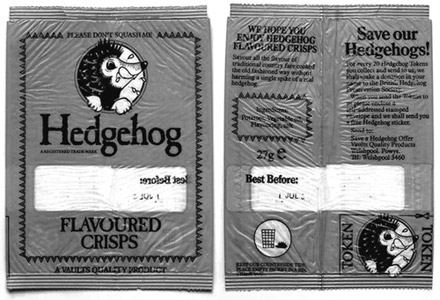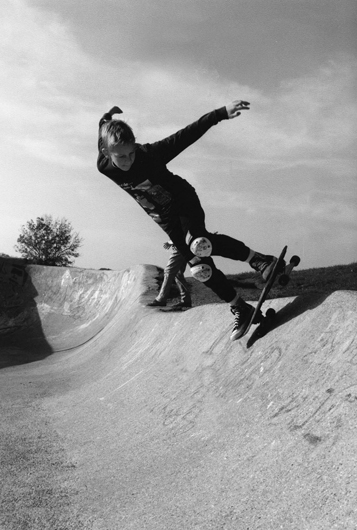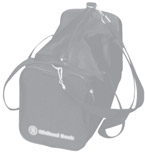A 1980s Childhood (21 page)
Authors: Michael A. Johnson

Consequently, the supermarkets of the eighties would be full of shoulder-padded women or bewildered men with trolleys full of the new and exciting convenience foods that had only recently appeared on the shelves. Take, for example, the Pot Noodle which appeared in 1979; if you could make a cup of tea, you could make a Pot Noodle – perfect for the unadventurous man whose wife had become a career woman. The manufacturers even targeted their adverts at men to show them just how easy it was to prepare their food in the absence of a woman. According to the adverts for Findus Crispy Pancakes, the pancakes were so easy to prepare that even a teenage boy could manage it while his mum was out at work. The sneaky teenage boy in the advert impressed his girlfriend by letting her think he had fantastic culinary skills and had made the pancakes from scratch, when in actual fact, he had just taken them out of the freezer and put them in the oven.
If you wanted potato with your meal, you didn’t need to scrub and peel real potatoes; you just added some hot water to Smash or chucked a couple of the brand-new Bird’s Eye Potato Waffles in the oven. For dessert, you could just add water again to a packet of butterscotch Angel Delight, or maybe, if you had guests, you could bring out the latest innovation in ice cream: the Vienetta.
What would be the perfect drink to accompany this 1980s convenience meal? Why, Blue Nun of course! Blue Nun was famously marketed as the wine that would accompany every meal perfectly, reducing the need for complicated wine pairings between courses and shaving vital seconds off mealtime preparation. If you preferred something non-alcoholic you could always open a can of TAB Clear cola, the colourless, sugarless cola that never really made it big; or maybe you could open that bottle of Corona limeade that the Corona man delivered to your doorstep every week.
Shoppers at a 1980s supermarket would take their goods to the tabard-wearing checkout assistant who would tap the prices into the till manually, fingers fast as lightning, pausing occasionally to hold up an embarrassing item which had lost its sticky price label and call out for a ‘price check’. Credit cards were becoming more widely used to pay for goods on the high street but they were still relatively new and mistrusted by many. Most customers still opted to pay for their goods with ‘real money’, like £1 notes, old-fashioned shillings, and maybe even some ha’penny coins up until 1984.
I didn’t do a lot of supermarket shopping in 1985 since I was just 8 years old and I was a lot more familiar with a different type of shop – the sweet shop. I used to be given 20p pocket money each weekend and as soon as I got it, I would rush off to the corner shop and spend the whole lot on a big bag of sweets. Items to choose from were things like Alphabet Candy, Beer Bottles, Cola Bottles, Anglo Bubble Gum, Candy Necklaces, Eyeball Gobstoppers, Space Dust, Candy Cigarettes, Bazooka Joe Bubble Gum, Skull Crushers, Flumps, Bullion Bars, Flying Saucers, Cola Roller Balls, Fireball Gobstoppers, Foam Magic Mushrooms, Gold Rush Bubble Gum, Horror Bags, Jaw Breakers, Mojos, Blackjacks, Fruit Salads, Parma Violets, Pez, Love Hearts, Pink Shrimps, Sherbet Dip Dabs or Fountains, Rainbow Drops and Wham Bars.
The corner shop also stocked a mouth-watering selection of crisps, including Ringos, Fish and Chips, Space Raiders, Scampi Fries, Piglets, Discos, Monster Munch and, my personal favourite, the highly controversial hedgehog-flavoured crisps. In 1981 a Welsh pub owner called Philip Lewis decided, as something of a joke, to invent hedgehog-flavoured crisps and was as surprised as everyone else when the crisps became enormously successful. He was also surprised when the Office of Fair Trading decided to bring a court case against him for false advertising, since they weren’t happy when they discovered that the crisps did not actually contain any hedgehogs at all. Mr Lewis explained that he had interviewed travelling gypsies, who enjoyed the occasional baked hedgehog or two, and took their advice on the flavourings required to recreate the authentic flavour of baked hedgehog. Well, to cut a long story short, Mr Lewis simply changed the label on the packet to read ‘hedgehog flavour’ instead of ‘hedgehog flavoured’, and everyone was happy again.

An original packet of hedgehog-flavoured crisps from 1981. This packet dates from just before the court case which resulted in the name of the crisps being changed ever so slightly to ‘hedgehog flavour’, instead of ‘hedgehog flavoured’.
(Public Domain)
Once we had stocked up on our sweets and snacks, my brothers and I would head back home in silence, unable to speak thanks to the giant gobstoppers crammed in our mouths. At the weekends we would usually meet up with our friends and spend the whole time playing in the street on our skateboards, setting up makeshift ramps and using them to jump over brave ‘volunteers’ (usually me) lying on the ground underneath. This was no sissy 1970s skateboarding, where the tricks involved girly handstands and stationary acrobatics while flare-wearing onlookers declared your tricks to be ‘wizard’; no, this was 1980s street skating and we weren’t ‘wizard’, we were ‘radical’. We were part of a new movement of gritty, urban skaters popularised by skateboarding magazines like
Thrasher
and
R.A.D.
(Read and Destroy). We would ollie, grind and rail-slide around the streets emulating our heroes, the famous skaters Tony Hawk, Steve Caballero and Rodney Mullen. We watched skate videos together, we read skate magazines and we even played skating computer games like ‘Skate or Die’ on the ZX Spectrum. The only problem was that I was no good at it. I couldn’t ollie to save my life and when I was towed behind a bike on my skateboard I got the speed wobbles, fell off and ended up in hospital.
When a friend of mine brought a skateboard into the office recently, all the excitement of the eighties came flooding back to me and we decided to take it for a whizz down the hill nearby. I’d completely forgotten that I was no longer a child and that I was never much good at skateboarding anyway, and so it came as something of a surprise when I came flying off the skateboard at great speed, landing on my face and ending up covered in bandages once more.

Me getting totally radical at the local skate park.
(Author’s Collection)
A marginally safer activity was riding our bicycles, although we still received our fair share of cuts, bruises and crossbar-induced testicular concussions. My brother had a bright yellow Mongoose BMX and I had a Raleigh Grifter that was so heavy that it felt like it was made of lead. The Grifter was the younger cousin of the Raleigh Chopper, a seventies cultural icon, and it looked like the sort of sporty BMX bike that would be ideal for performing stunts and tricks. However, it weighed in at around 35lb making it far too heavy for any child to ever do any jumps on it, which was probably just as well with my safety record. Instead of attempting to get airborne on the bike, I would Sellotape some Brooke Bond PG Tip tea cards on to the frame, sticking into the spokes, so that as I rode along, the cards flapped against the spokes and made a kind of ‘vroom’ noise like a motorbike. At my request my dad bought me a rear-view mirror for the bike and, when combined with the ‘vroom’ noise from the spokes, the twist shift gears and the excessive weight of the bike, I was able to pretend I was one of the motorbike-riding characters from CHiPs.
My younger brother would join in and pretend he was on a police motorbike as he rode around on his Raleigh Bluebird, a younger child’s bike that had a sky-blue frame, white tyres, a white saddle and white handle grips. It came equipped with stabilisers and a little carry box mounted on the rear mudguard that came in handy for transporting our toy handcuffs and revolver.
Sometimes we would head up to the woods on our bikes where someone had made a kind of dirt racetrack with hard-packed mounds of earth that acted as ramps and obstacles. My brother, on his lightweight Mongoose BMX, would speed around the track clearing every obstacle with ease, soaring gracefully through the air over the various ramps. I would follow on my super-heavy Grifter, ploughing through the obstacles with sheer, unstoppable momentum before attempting one of the ramps; my weighty bike always remained firmly rooted to the ground while I soared gracefully through the air, just like my brother, except without a bike.
Just next to the dirt track in the woods was the local Scout hut where my brother and I went once a week for Cub Scouts. We would dress in the traditional Cub’s uniform of grey shorts, green jumper, green cap and a striped neck scarf, with a red ‘woggle’ to fasten the scarf. We also had to wear green-tabbed garters around our knee-length grey socks.
Each week we would solemnly declare our oath to Akela and give a three-fingered salute as the Union Jack flag was raised on a piece of string indoors (we didn’t have a flagpole to use outside). Aside from the weekly meetings where we learnt to tie knots, start fires and practise basic first aid, we would occasionally be taken on special outings or would take part in activities that earned us badges that we could proudly stitch onto the sleeves of our jumpers. Once a year, we would take part in ‘Bob-a-Job’ week which involved knocking on the doors of neighbours and asking if they had any odd jobs we could do to earn some money. Bob-a-Job week started just after the Second World War and the participating Scouts would be paid 5p per job (‘bob’ is the old name for a shilling, now 5p), but in the 1980s inflation meant that I could charge up to 50p per job. This was no easy money-making scheme, though, and I would be expected to work hard for my 50p. I remember weeding an elderly neighbour’s garden for over an hour to earn 50p, washing my dad’s car to gleaming perfection for another 50p and cutting another neighbour’s enormous lawn with a heavy old-fashioned mower for another 50p. Frustratingly, all the money I had worked so hard to collect had to be given to the Scouts for their fundraising collection and I never got to keep a penny of it. I think the idea was to teach young boys the value of voluntary service and community spirit, but it taught me a different lesson: that hard work was futile and that community spirit meant giving up your weekends so that elderly neighbours could take advantage of your good nature.
I worked pretty hard over the years to raise money for the Scouts as I would also go door-to-door each week with a wheelbarrow collecting stacks of old newspapers to take to the Scout hall so they could sell the paper for recycling. I reckon the Scouts did pretty well out of me.
Well, it’s been a real pleasure showing you around my home town of the 1980s and I hope it has brought back as many good memories for you as it has for me; but now it’s time to move on and take a look at what it was like going to school in the eighties.
S
KOOL
D
AZE

Remember that old ZX Spectrum computer game ‘Skool Daze’ from 1985? Well, I never really figured out what I was meant to be doing in that game – I guess I just never read the instructions – and so I spent many happy hours guiding my character Eric aimlessly from classroom to classroom with the vague feeling that I was probably in the wrong lesson at the wrong time, and occasionally getting told off by teachers whose names I didn’t know. And in this respect ‘Skool Daze’ bore a remarkable similarity to my own, real-life experience of attending school in the 1980s.
